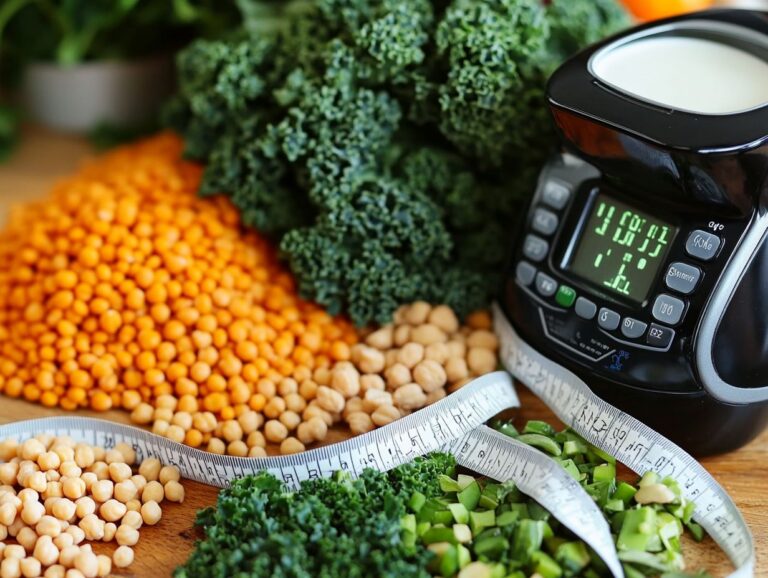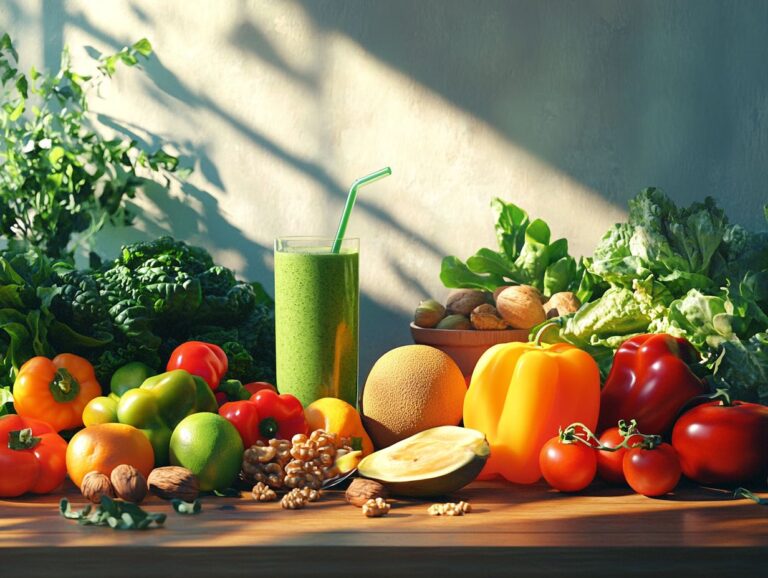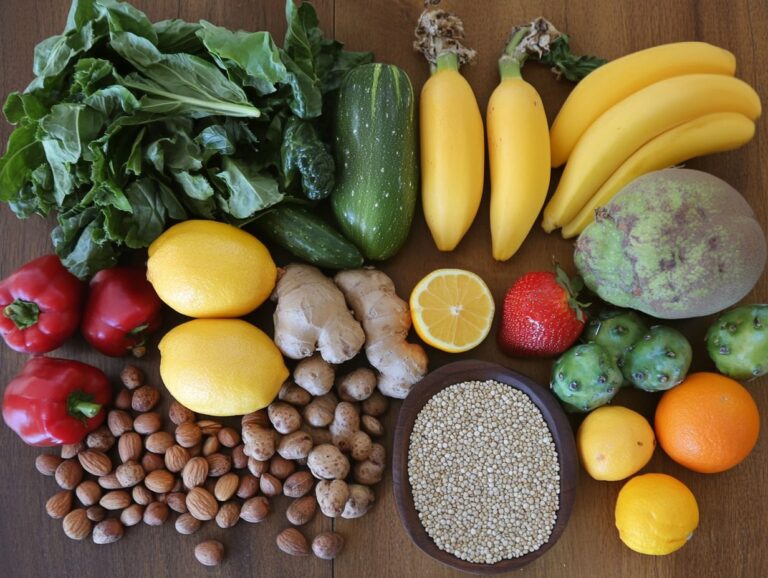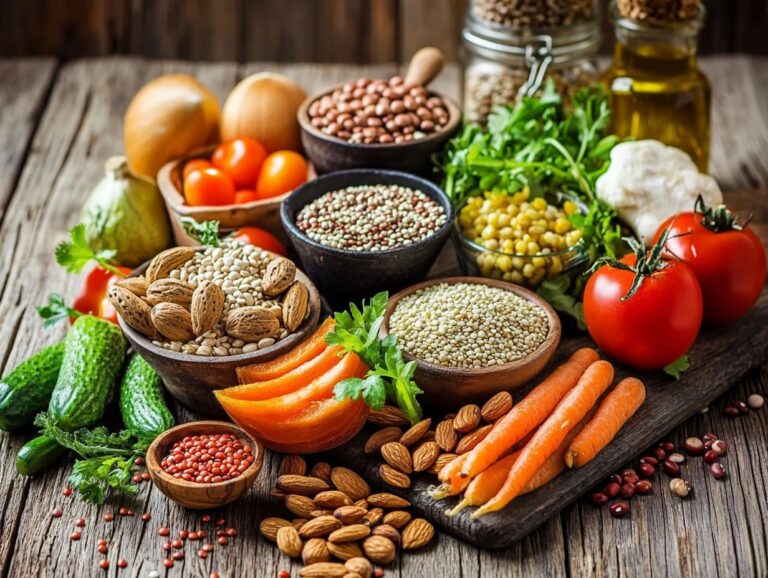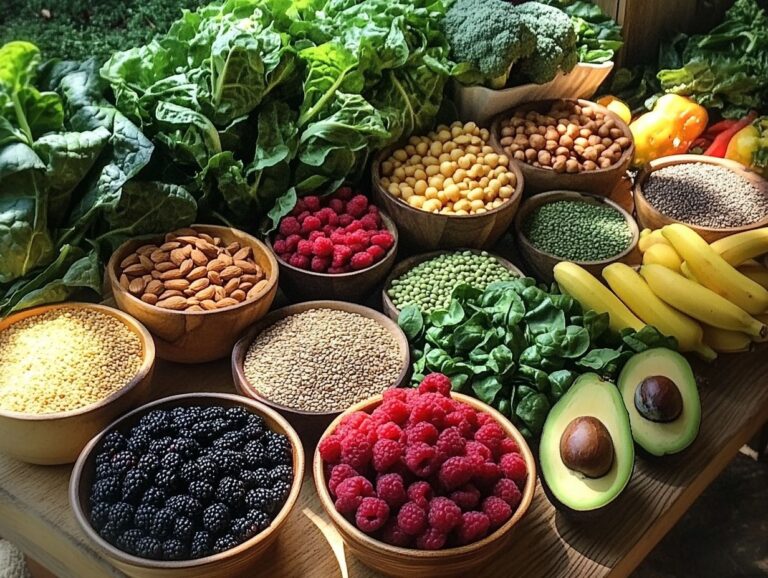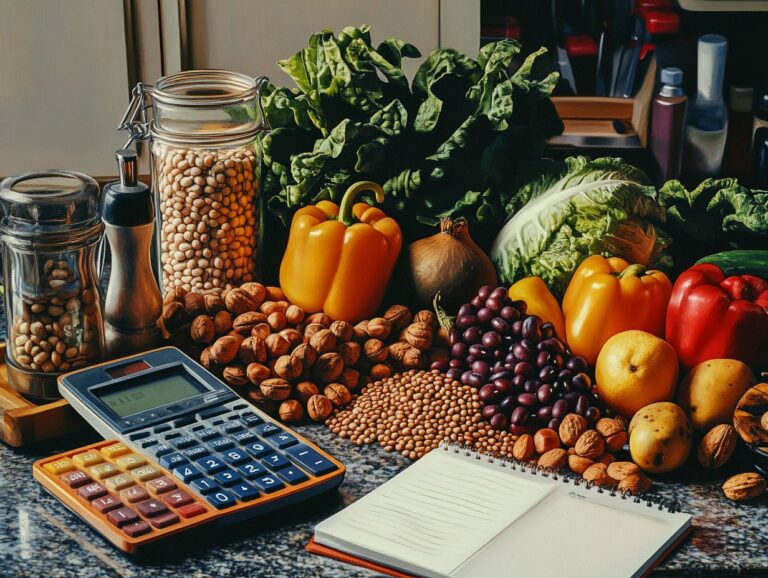The Vegan Abs Diet is a distinctive vegan meal plan tailored for individuals seeking a sculpted core while adhering to a plant-based diet. This diet emphasizes nutrient-rich foods that are high in fiber, plant-based proteins, and low in calorie density, making it an effective choice for weight loss, muscle building, and overall wellness. In this guide, you will discover the main features of the Vegan Abs Diet, its numerous benefits, essential tips for success, potential challenges, and guidelines for following the diet, including a meal plan grocery list and flexible food choices. Learn how to transform your eating habits and enhance your core strength—all while enjoying delicious vegan recipes!
Key Takeaways:
- Incorporating high fiber foods in the Vegan Abs Diet can improve digestion and aid in weight loss.
- The Vegan Abs Diet is a plant-based plan that includes low calorie density foods, helping to sculpt your core and reduce inflammation.
- When starting the Vegan Abs Diet, it is important to plan meals, incorporate variety, consult with a registered dietitian for support, and join a private Facebook group for motivation and personal advice.
What is the Vegan Abs Diet?
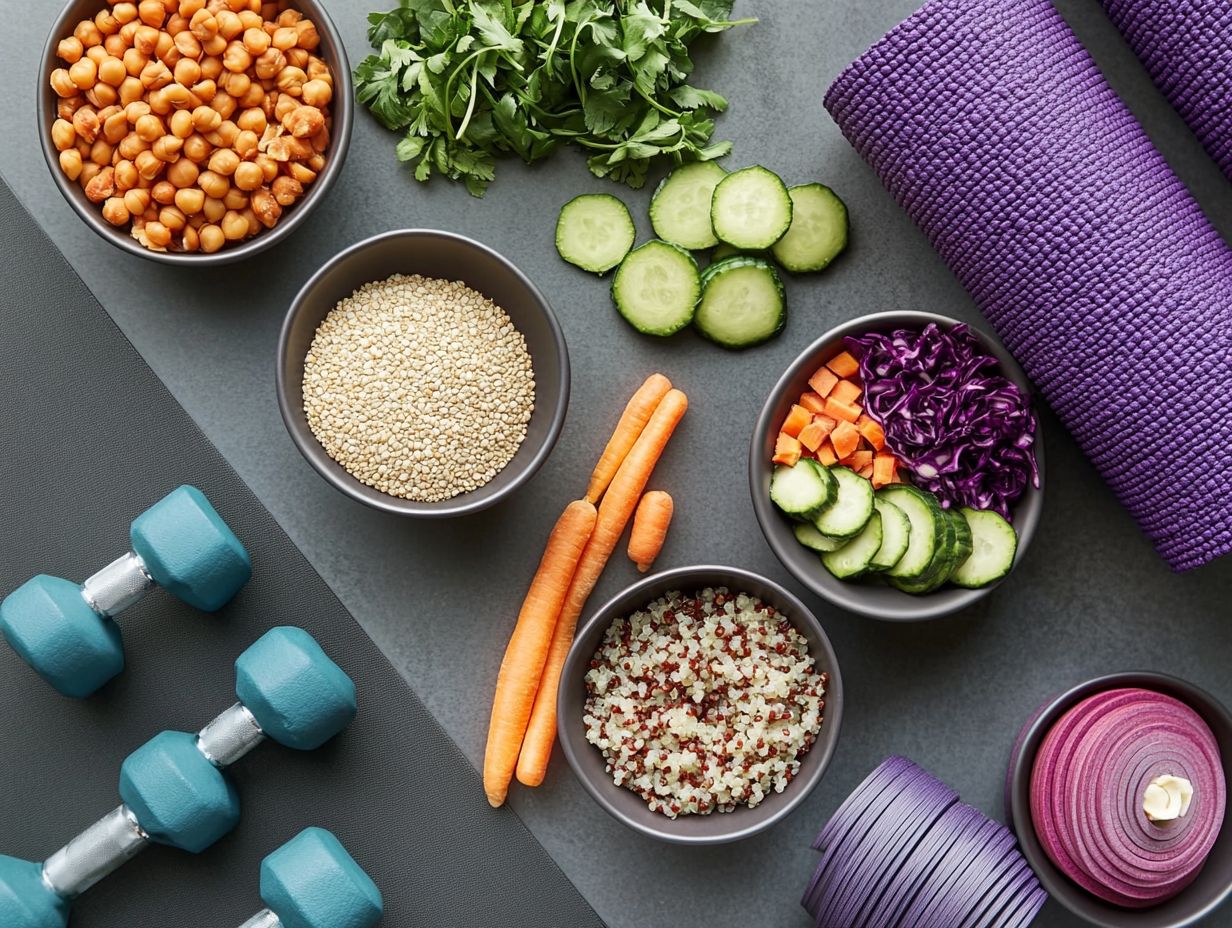
The Vegan Abs Diet is a structured eating plan designed to promote fat loss and muscle building through nutrient-dense recipes that support fitness goals, such as achieving toned abs.
This diet focuses on whole, plant-based foods, incorporating a wide variety of fruits, vegetables, and legumes, while also controlling calorie intake to encourage weight loss and enhance overall well-being.
What Foods Are Included in the Vegan Abs Diet?
A Vegan Abs Diet is a plant-based meal plan designed to support metabolism and muscle development while promoting fat loss.
This diet is rich in nutrient-dense foods, including chickpeas, quinoa, tofu, kale, broccoli, and amaranth, which are essential for maintaining energy levels and achieving overall health.
How Does the Vegan Abs Diet Help Sculpt Your Core?
The Vegan Abs Diet is designed to shape the core by providing essential nutrients while focusing on fat loss and muscle gain—two key components for achieving your fitness goals.
This diet encourages portion control and is most effective when combined with a workout program that includes core strengthening exercises, such as the 28 Day Abs Challenge, ensuring optimal results such as visible flat abs.
1. High Fiber Intake
A high fiber intake is a cornerstone of the Vegan Abs Diet, as it promotes better digestion and helps maintain a healthy weight by keeping you fuller for longer periods.
Foods rich in fiber, such as quinoa, beans, and leafy greens, contribute to an optimal nutrient breakdown that is essential for achieving fitness goals and maintaining a healthy vegan lifestyle. Incorporating these high-fiber foods not only enhances digestive health but also plays a crucial role in stabilizing blood sugar levels, which is important for sustaining long-term energy during workouts and supporting overall fitness goals.
For example, a hearty lentil soup or a vibrant quinoa salad packed with vegetables can serve as satisfying meal options that fuel your body while supporting weight management.
By planning meals around fiber-rich ingredients, such as customizable bowls and stuffed sweet potatoes, individuals can create delicious vegan recipes that align seamlessly with their fitness objectives, ensuring they meet their daily nutritional targets without sacrificing taste or satisfaction.
2. Low Calorie Density Foods
In the Vegan Abs Diet, low-calorie-density foods play a crucial role in fat loss, as they allow for larger portions without a significant caloric intake. Foods such as leafy greens, fruits, and legumes, like plant-based pasta and veggie wraps, can be consumed in generous quantities without exceeding calorie limits, thus promoting weight loss while providing essential nutrients for overall health.
Foods with higher water and fiber content, like cucumbers and berries, such as in hidden veggie smoothies, can help you feel full without adding many calories. Healthy snacks that maintain energy levels and prevent excessive hunger throughout the day and during workouts include:
- Colorful fruit kabobs made from seasonal produce, and protein smoothie
- A trail mix of unsalted nuts and dried fruits
3. Plant-Based Protein Sources
Plant-based protein sources play a crucial role in the Vegan Abs Diet, providing the essential amino acids necessary for muscle building and maintenance, essential for those following a vegan lifestyle. Incorporating foods such as quinoa, chickpeas, and vegan protein powder ensures adequate dietary protein intake while adhering to the principles of a compassionate lifestyle.
These proteins not only fuel exercise but also aid in recovery by helping to repair muscle tissue after strenuous workouts. For those following this diet, integrating a diverse range of sources such as lentils, edamame, and hemp seeds can further enhance meals, as well as providing food alternatives for variety.
A practical approach is to create protein-rich smoothies using spinach, bananas, and plant-based protein powder for a quick and healthy breakfast, or enjoying vegan ice cream for a treat. Alternatively, preparing build-your-own tacos filled with black beans, roasted vegetables, and avocado offers a delicious way to incorporate these proteins while allowing for customization based on individual preferences, fitting well into a diverse vegan meal plan.
What Are the Benefits of Following a Vegan Abs Diet?
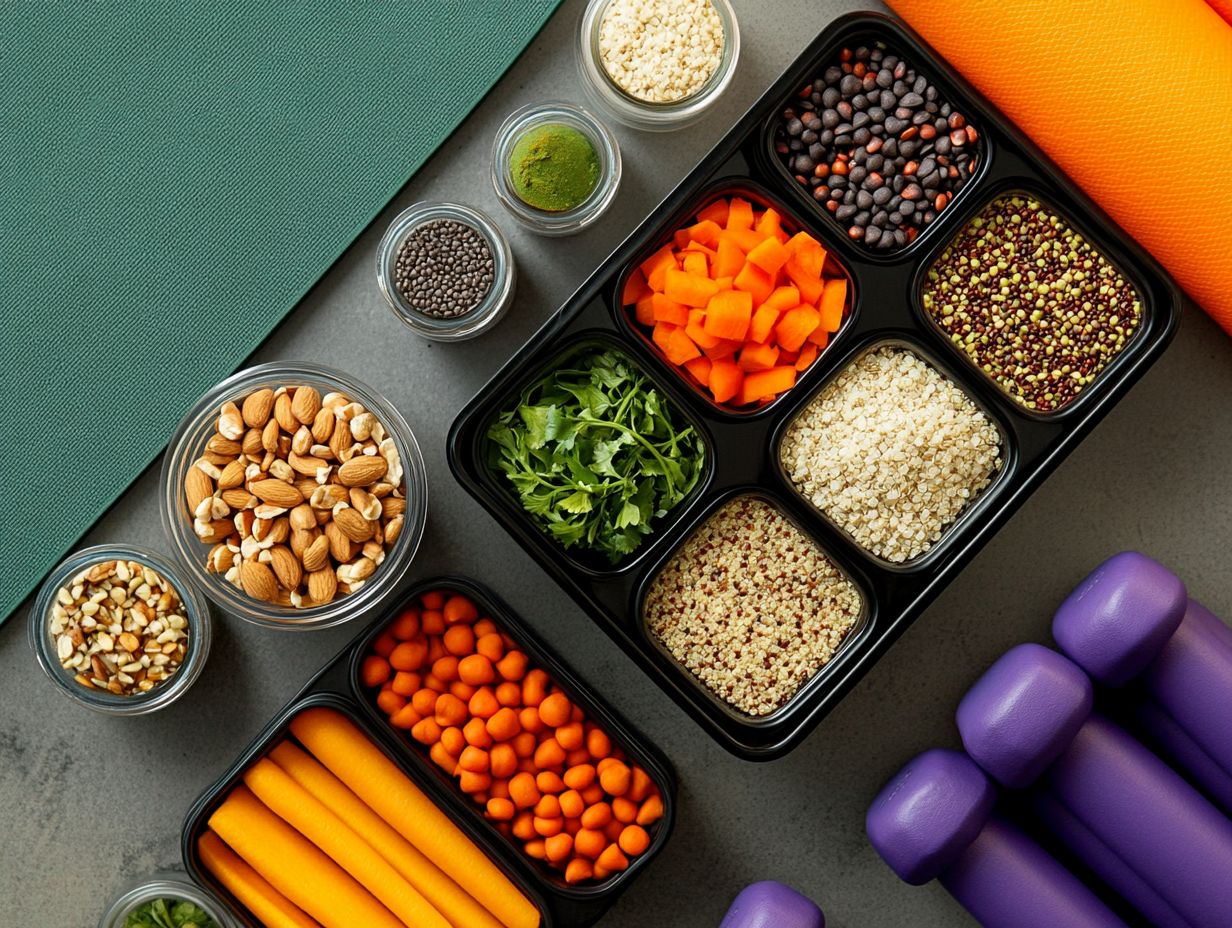
The Vegan Abs Diet offers several benefits, including improved digestion, increased energy levels, weight loss, and reduced inflammation, making it a successful program for many.
Not only is this diet effective for achieving fitness goals, but it also promotes overall health by emphasizing whole foods and plant-based options that supply the essential nutrients your body needs, helping you maintain a balanced diet.
1. Improved Digestion
One of the key benefits of the Vegan Abs Diet is its ability to enhance digestion, primarily due to the high fiber content of the foods it includes. This fiber promotes healthy regularity and improves nutrient absorption.
Leafy greens and whole grains are essential for ensuring that the body’s systems have the necessary support for optimal digestive function and effective nutrient utilization. By incorporating a variety of legumes, fruits, and nuts, individuals can further optimize their digestion.
Foods like chickpeas and lentils can be added to salads to increase fiber content and improve texture. Whole grains such as quinoa and brown rice serve as excellent base components for meals within the Vegan Abs Diet, as they facilitate a steady release of energy while also benefiting gut health.
Additionally, fruits like apples and bananas make great mid-day snacks, providing a natural sweetness while aiding digestion. Healthy snack ideas like trail mix can also be beneficial. Thoughtful meal planning that combines these foods effectively is an excellent approach to establishing a healthy digestive tract.
2. Increased Energy Levels
The Vegan Abs Diet promotes increased energy levels through recipes that utilize metabolism-boosting ingredients and nutrient-rich whole foods, ensuring the body is fueled throughout the day. Whole foods help maintain steady energy levels and support proper workout recovery.
A diet rich in protein, fiber, and healthy fats can significantly boost energy levels, enabling individuals to complete their daily tasks without experiencing the afternoon slump. Following a structured meal plan can help manage portion sizes and ensure consistent energy.
For instance, a protein smoothie made with spinach, banana, and almond milk offers a refreshing breakfast option packed with nutrients, suitable for any vegan meal plan. Hidden veggie smoothies, which incorporate dark greens like kale or cucumber into fruit smoothies, provide a delicious way to add vegetables to the diet without altering the taste. Similarly, nutrient-dense recipes can be used for variety and enhanced nutrition.
Additionally, energy bites made with oats, nut butter, and chia seeds serve as a great snack option, as they provide a sustained release of energy and help keep metabolism active throughout the day.
3. Weight Loss
Weight loss is a significant benefit of the Vegan Abs Diet, as it encourages a lower caloric intake while promoting eating habits that ensure satisfaction without excess. This approach not only facilitates fat loss but also makes it easier to achieve fitness goals.
Nutrient-dense, plant-based foods offer meals rich in fiber, which aids digestion and contributes to a feeling of fullness. By emphasizing whole foods such as vegetables, fruits, legumes, and whole grains, the diet supports a lower caloric intake while providing essential vitamins and minerals.
Careful meal planning—preparing meals in advance and controlling portion sizes—can help prevent impulsive eating and promote better calorie management. Using a meal planning strategy that includes a grocery list can also be helpful. Additionally, using measuring devices and visual indicators allows for portion control without sacrificing flavor.
This demonstrates that weight loss does not have to come at the expense of enjoying delicious meals.
4. Reduced Inflammation
Reduced inflammation is another key benefit of the Vegan Abs Diet, as plant-based nutrition has been shown to decrease inflammatory responses in the body.
Consuming a variety of whole foods rich in antioxidants is essential for a healthy lifestyle and overall well-being.
Foods such as berries, leafy greens, nuts, and whole grains are particularly packed with nutrients that nourish the body and help reduce chronic inflammation.
The omega-3 fatty acids found in flaxseeds and walnuts play a significant role in lowering inflammation, while colorful fruits and vegetables provide essential vitamins and minerals that promote good health.
By incorporating these nutrient-dense options into their daily diet, individuals can achieve a balanced nutritional intake that supports long-term health and enhances disease resistance, benefiting their overall vegan lifestyle.
Ultimately, this leads to a stronger immune system and improved overall physical performance.
What Are Some Tips for Following the Vegan Abs Diet?
Meal planning and flexibility are essential components of the Vegan Abs Diet, enabling individuals to customize their meal plans based on personal preferences and nutritional needs. Access to coaching support and a private Facebook group can provide additional guidance and motivation.
Here are some tips for adhering to this plant-based diet in a manner that aligns with your fitness goals.
1. Plan Meals Ahead of Time
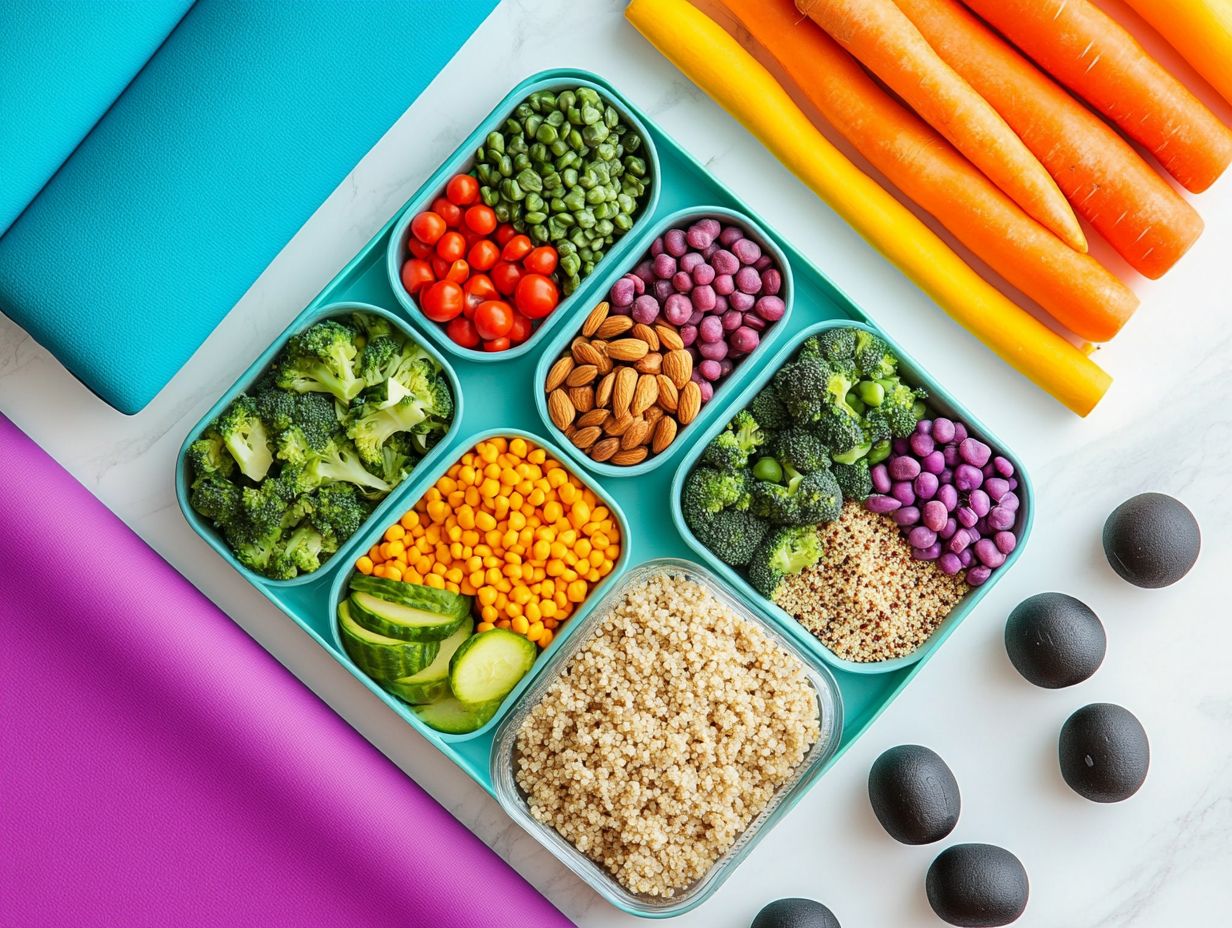
Meal preparation is essential for the Vegan Abs Diet, as it allows individuals to have better control over their grocery lists and ensures healthy recipes are readily available. This practice helps keep meals aligned with fitness goals.
By dedicating a small amount of time each week to meal planning, individuals can avoid default choices that often lead to poor eating habits. A well-structured meal plan not only meets the nutritional demands of a vegan diet but also simplifies the cooking process, making adherence to the diet more manageable.
To create a grocery list that reflects the ingredients needed for optimal meal preparation, start by gathering recipes that feature whole, plant-based foods. This approach not only simplifies grocery shopping but also encourages the incorporation of a variety of vegetables, legumes, and grains, providing a delicious assortment throughout the week.
2. Incorporate Variety
The Vegan Abs Diet emphasizes the importance of variety in meals to prevent boredom and ensure an adequate intake of micronutrients.
Customizable bowls or build-your-own tacos provide a range of choices, allowing for filling meals tailored to meet individual dietary needs. This approach not only enhances the taste experience but also promotes health by varying micronutrient profiles.
For instance, you can start with a base of quinoa or brown rice, then add colorful vegetables such as bell peppers, kale, and cherry tomatoes. Incorporate protein sources like chickpeas or lentils, and finish with a topping of seeds or nuts for healthy fats. Experimenting with different herbs and spices can elevate the flavor from bland to fabulous.
Utilizing seasonal produce ensures nutrition and freshness throughout the year, making it easier to maintain a sustainable vegan lifestyle.
3. Stay Hydrated
Hydration plays a crucial role in the Vegan Abs Diet, as it is essential for overall health and aids digestion and healthy living. Regular daily hydration can enhance the effectiveness of a detox program and help individuals achieve their fitness goals more quickly.
Drinking adequate fluids is important for maintaining energy levels, improving nutrient absorption, and supporting the body’s natural detoxification processes. It is essential to drink water at regular intervals throughout the day, with a baseline recommendation of eight glasses daily, which can be adjusted based on activity levels and temperature.
Consuming flavored herbal teas or infused waters can make staying hydrated more enjoyable, serving as healthier alternatives to sugary beverages. Infusing water with fresh fruits such as lemons, berries, or cucumbers can add natural flavors, vitamins, and antioxidants.
Additionally, it is important to monitor the body’s natural thirst cues and take small sips of water regularly, especially before, during, and after exercising.
4. Listen to Your Body
Listening to your body while following the Vegan Abs Diet involves adjusting your nutrition to meet your unique nutritional requirements and personal preferences. This approach promotes a healthy diet that supports long-term success and sustainability.
By being attuned to your hunger and fullness signals, you can make better choices regarding portion sizes and foods that align with your physical and emotional needs. For instance, serving smaller portions initially can help you assess your true hunger before considering seconds.
Additionally, incorporating a diverse array of colorful fruits and vegetables can enhance nutrient intake and address emotional eating, as these foods tend to be more satisfying.
Are There Any Potential Challenges or Drawbacks to the Vegan Abs Diet?
The disadvantages of the Vegan Abs Diet include challenges in meeting nutrient needs and limited dining options when eating out.
Understanding these drawbacks is essential for adequately preparing for and successfully transitioning to this diet.
1. Difficulty Meeting Nutrient Needs
The Vegan Abs Diet has a potential downside: it may be challenging to meet specific nutrient needs, particularly regarding protein and micronutrients that are naturally harder to obtain from a plant-based diet. However, this can be addressed through careful planning and a good understanding of food alternatives.
To meet protein requirements, it is essential to consume a variety of plant-based sources, such as:
- Legumes
- Quinoa
- Nuts
while also incorporating protein-rich foods like tempeh and tofu. Additionally, certain vitamins, such as B12, vitamin D, and omega-3 fatty acids, may need to be supplemented, which can be achieved through fortified foods or high-quality supplements.
Incorporating meals like smoothies with hemp seeds, lentil salads, and snacks such as edamame or chia pudding can help create a balanced diet that provides the necessary vitamins and minerals while supporting fitness goals.
2. Social Challenges
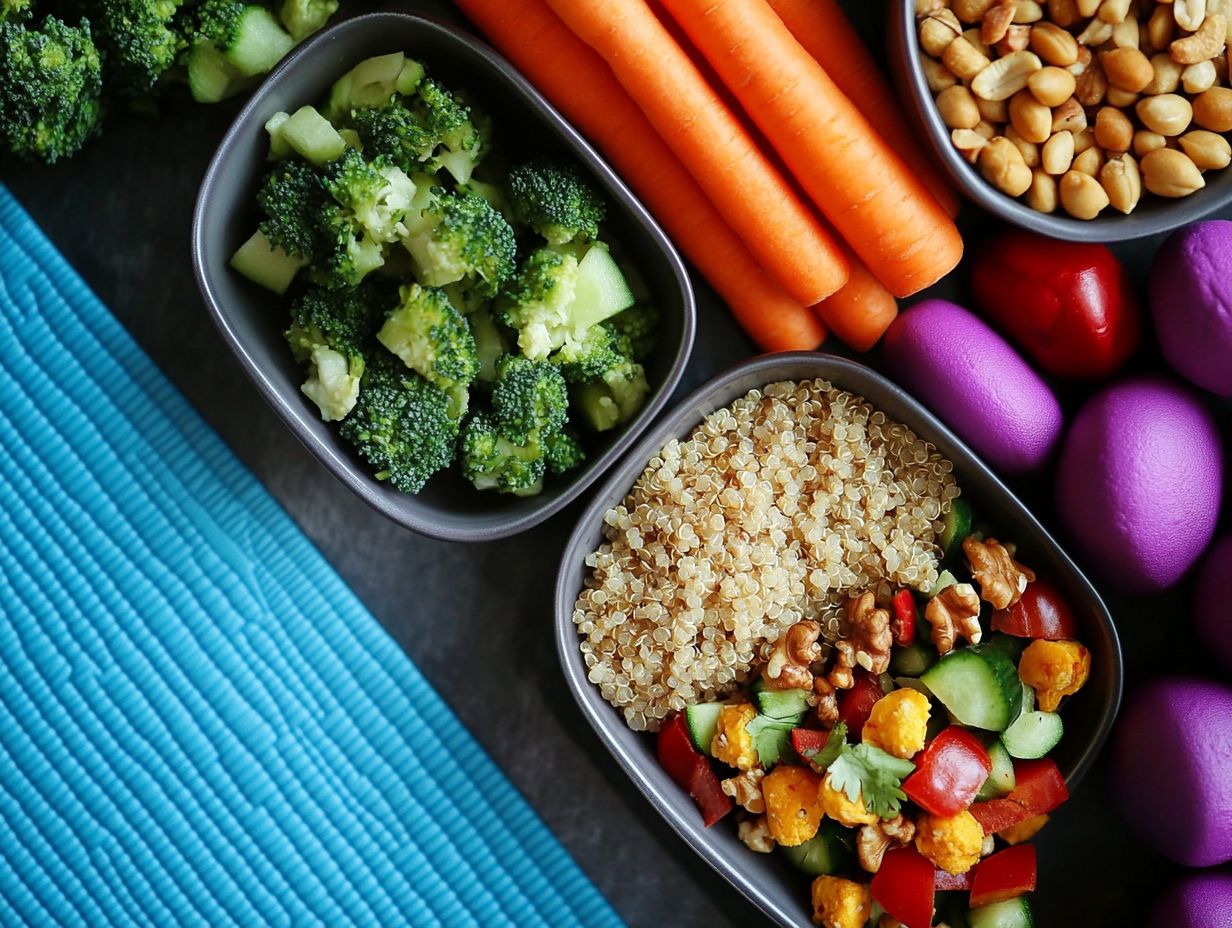
The social challenges associated with the Vegan Abs Diet are quite common, particularly in settings where plant-based meal options are limited. However, establishing a support system and seeking out community resources can significantly enhance your experience and help you remain committed to your dietary goals.
Social situations, such as dining at restaurants or attending potluck dinners, may present difficulties, but with some preparation, these challenges can be effectively managed.
When eating out, consider researching local restaurants that offer vegan-friendly meals, or call ahead to inquire about options for customized dishes. If you are attending a social gathering, it can be beneficial to inform your friends about your dietary choices and encourage them to accommodate you in the future.
This approach fosters mutual understanding and may even inspire them to explore their own dietary preferences.
Joining supportive communities, such as private Facebook groups and local meet-ups, can provide valuable tips, encouragement, and a sense of belonging among others with similar dietary aspirations.
By sharing your experiences and challenges within these communities, you can help one another stay motivated and maintain a positive outlook.
3. Limited Dining Options
Limited dining options pose a challenge for those following the Vegan Abs Diet, as it can be difficult to find food that meets their vegan, low-calorie, high-protein, and low-carb requirements at restaurants and social events.
However, eating healthier becomes much easier with proper meal planning and research into food alternatives in advance. Many individuals on the Vegan Abs Diet find themselves struggling with restricted dining choices, which can lead to stress when eating out.
To simplify the process of finding suitable food, consider meal prepping and packing snacks before you leave home. Researching vegan-friendly restaurants ahead of time can also be beneficial, as many modern urban areas feature establishments that cater to diverse plant-based diets.
If friends or family wish to dine out or invite you over for a meal, don’t hesitate to communicate your preferences or dietary restrictions. This way, everyone can enjoy the experience together.
How to Get Started on the Vegan Abs Diet?
A registered dietitian specializing in plant-based nutrition can assist individuals looking to start the Vegan Abs Diet by offering personalized guidance and support.
Useful resources for this transition include:
- Meal plans
- Grocery lists
- Recipes
1. Consult with a Registered Dietitian
The Vegan Abs Diet can greatly benefit from the support of a registered dietitian at the beginning of the journey, as they can tailor the diet to meet individual nutritional needs. This additional guidance can help navigate challenges and enhance the diet’s effectiveness.
A dietitian can assist with several key areas:
- Meal Planning: It is essential to ensure that each dish is both delicious and nutrient-dense to maintain energy levels and overall health. A dietitian can help achieve this balance.
- Nutrient Monitoring: A dietitian can monitor nutrient intake to ensure it meets optimal levels and identify any deficiencies that may arise when fueling the body with plant-based foods.
- Adaptations: As dietary needs evolve, a dietitian can recommend necessary adjustments to help you stay aligned with your goals.
- Long-Term Success: With the expert guidance of a dietitian, achieving long-term success becomes more attainable, allowing you to fully embrace the lifestyle changes associated with the Vegan Abs Diet.
2. Gradually Transition to a Vegan Diet
Gradually transitioning to a Vegan Abs Diet allows for a smoother adjustment by enabling individuals to slowly incorporate plant-based foods while replacing animal products with healthy substitutes. This approach minimizes discomfort and helps individuals learn new routines more effectively.
Instead of making drastic changes overnight, which can be overwhelming, this gradual method encourages exploration and experimentation with a variety of delicious vegan options at a comfortable pace. For example, one might start by designating specific days of the week as plant-based, gradually increasing the number of meatless meals.
Meal planning is essential in this process; dedicating time each week to plan meals ensures a balanced diet rich in variety, including legumes, whole grains, seasonal fruits and vegetables, and customizable bowls that incorporate nutrient-dense recipes such as plant-based pasta and stuffed sweet potatoes.
Incorporating new vegan foods into established recipes makes the transition less daunting, allowing individuals to rediscover their culinary favorites while adapting them to align with their new dietary preferences. Explore hidden veggie smoothies and fruit kabobs as part of your meal plan grocery list to enhance variety and ensure your nutritional needs are met.
3. Find Support and Resources
Finding support and resources is essential for successfully following the Vegan Abs Diet, as connecting with others and utilizing available tools can enhance the experience and provide motivation. Engaging with a community that shares fitness goals and participates in a 28 day workout program helps in reaching toned abs and achieving fat loss.
Joining a community offers valuable insights and encouragement, facilitating a smooth transition to a balanced diet and a healthier lifestyle. Engaging with others who are pursuing similar dietary changes fosters accountability and support, both of which are crucial. Consider engaging in a workout challenge or detox program to further support your vegan lifestyle.
For instance, becoming a member of a private Facebook group dedicated to the Vegan Abs Diet allows individuals to share experiences, ask questions, and seek advice from those who have been on this journey for a longer time. Additionally, participating in discussions about vegan protein powder and plant-based nutrition can offer insights into protein intake and macro count.
Additionally, participating in a coaching support program can provide personalized guidance to navigate challenging situations effectively. This includes receiving personal advice on workout techniques and ab sculpting to achieve core strengthening.
There are also numerous valuable resources available, including recipe books filled with creative meal ideas and online forums where members share tips. Consider exploring meal plans that include healthy snack ideas like trail mix, veggie wraps, and vegan ice cream. Together, these connections can help individuals stay motivated and inspired throughout their dietary journey.
